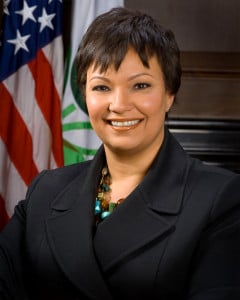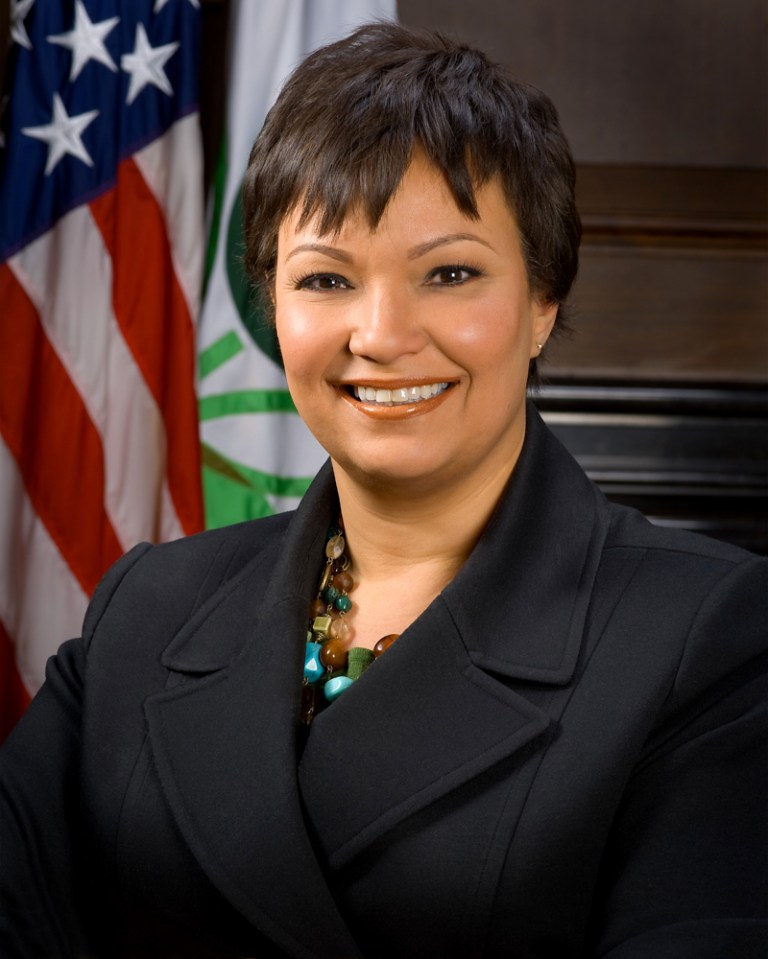
Lisa Jackson, administrator of the Environmental Protection Agency (EPA) from 2009-2013, spoke to students yesterday evening about her life in both the public and private sectors. The talk was the second annual Steven H. Schneider Memorial Lecture, and was held in Memorial Auditorium.
Before her lecture, The Daily spoke with Jackson – who currently serves as Vice President of Environmental Initiatives at Apple – about her tenure at the EPA, her time at Apple and the future of energy in the United States.
The Stanford Daily (TSD): The United States’ oil imports are at their lowest level since 1988, in part due to growing energy independence spurred by renewables and a domestic fossil fuel boom. Is this good or bad for America’s energy future?
LJ: First of all, I think the causes [of increasing energy independence] are myriad. We saw a decline in the amount of oil and gas used because of the recession, and when the economy slows down, the amount of energy that businesses use often slows down. We also saw a doubling of fuel economy standards in the first Obama Administration…But I think from the standpoint of energy and the mix of energy, it’s not surprising that in any transition…that you’re going to see some of those energy forms phase out.
So your question was whether it’s good or bad, I think it’s normal, it’s expected. But, hopefully we see businesses like Apple that lead and say, hey we can do this. We can run a business, we can run a data center, we can run a manufacturing site on renewable energy.
TSD: Apple now powers its facilities and data centers through almost exclusively renewable energy, but a large portion of Apple’s carbon footprint is in manufacturing and consumer product use. What’s being done to address this side of the company’s energy policies?
LJ: Apple does a really detailed and thorough carbon footprinting. We call it a lifecycle analysis. You’re absolutely right, the thing that makes it innovative is when we start making one of our products. We track the aluminum, for example, all the way back to the mine. We know the footprint of that aluminum and we include it in our carbon footprint, even though we don’t own the mine, we don’t own the smelter, we don’t own any of those processes.
We believe that by tracking it we can then drive to something better. If you look at that carbon footprint, the largest part is definitely in the manufacturing and supply chain, and the second largest is actually the use of our products by the people who own them. So we track and take charge of the footprint of your use, this iPhone for example. So we can reduce our carbon footprint by reducing your use.
TSD: You were one of the first EPA administrators to have been a career scientist, but you had to deal with huge administrative crises like the Gulf oil spill. How has being a trained scientist helped you as EPA administrator and in your current position at Apple?
LJ: Absolutely. I’m a chemical engineer by training, with a master’s degree. It’s not like you sit down [and stop using scientific skills] when you’re managing a large organization. The EPA has 17,000 people. It’s a huge organization with amazing scale and scope. You use the managing skills you have, certainly, as you begin to manage people, but you also use the problem solving skills. Engineers are trained as problem-solvers [and] scientists are trained in the scientific method.
I think for us at the EPA, most people don’t realize how incredibly complex the science of protecting the environment has become. Air modeling to look at air pollution is pretty complex stuff. Or, the monitoring systems that we use have evolved to the point that they’re very compact but also very precise. Or, cleaning up a contaminated aquifer requires lots of technical skills…I always thought it was a particular help not only that I was a scientist but that I had been for 20 years working for the EPA and almost 22 years working for the environmental field before I became administrator.
TSD: What can a student at Stanford do to improve America’s energy future?
LJ: Learn. The key to environmental protection increasingly is innovation. What I thought and continue to believe in progress is innovation – people who take the challenges that frankly have been around for decades and some new ones and say I don’t see that challenge as something we just have to deal with, I see it as an opportunity. [It’s] an opportunity to make money, an opportunity to start my own business.
I think obviously Stanford has done an amazing job of teaching folks everything from green design to sustainability to system oriented thinking, the idea of how to create value for your business while creating value for the environment and society as a whole. As students, what Stanford excels at is teaching you that kind of thinking. When you get out, you can bring with you all that innovation, creativity and probably a measure of experience to solve those challenges.
Contact Victor Xu at vxu ‘at’ stanford ‘dot’ edu.
